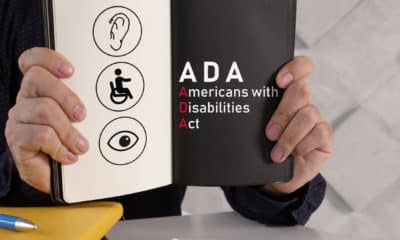The Americans With Disabilities Act (ADA) represents freedom from discrimination to disabled persons. To many business owners, it represents yet another bureaucratic tangle. Briefly stated, ADA regulations require the removal of barriers in existing facilities, the provision of auxiliary aids for people with vision, speech, and hearing impairments, and accessible new constructions and alterations.
There are two parts to this law. One deals with public accommodation and specifies what business owners must do to meet special needs of disabled people. The other deals with employment provisions and how employers must deal with disabled employees and job applicants.
Public Accommodation Regardless of size, a business which is considered a "public accommodation" must eliminate obstacles that restrict accessibility or availability – but only "if it is not too expensive, disruptive, or difficult, and IF reasonable efforts have been made to comply." Small business owners will have to rely on common sense until the courts define "reasonable effort."
Practical and reasonable changes might include providing a wider path of travel for disabled persons, grab bars in bathrooms, modified telephones, 36" doorways, levers on doors instead of knobs, entrance ramps, support rails, removing turnstiles. Be sure to explore options. For instance, if no other practical way of complying with this requirement is found, a sign might be posted on the front door offering sidewalk services to disabled people.
When making (or planning to make) alterations to existing facilities, compliance with this Act must be included in the plans. New construction must meet all accessibility rules.
The cost of complying with this Act is estimated by lawmakers to be nominal – 31% of the changes will cost nothing at all, 19% are expected to cost less than $50, and 31% will cost more than $500. Tax credits of up to 50% of costs incurred between $250 and $10,250 are available to businesses that comply. To be eligible, businesses must have 30 or fewer employees and less than $1 million in gross receipts.
Advertisement
A small business "public accommodation" includes almost every retail, rental, service, entertainment, or transportation business. (Examples include beauty and barber shops, restaurants and bars, motels, bakeries, accounting and law offices, travel and insurance agencies, gas stations, repair services, recreational facilities, day care establishments and private schools, etc.)
All business regardless of size that are considered public accommodations must comply with the public accommodations provisions. The effective date was January 26, 1992, for businesses with 25 for fewer employees and annual revenues of $1 million. Businesses with 10 or fewer employees and revenues of $500,000 or less had until January 26, 1993, to comply.
Employment Provisions— Employers cannot discriminate against qualified individuals because of disabilities. It is illegal to exclude anyone from the application process. That means barriers must be removed (for example): if a person is deaf, an interpreter must be obtained to assist with the interview). Disabled people must have equal access to job opportunities, promotions, and benefits and privileges afforded other employees (including off-site training and conferences).
"Disability" means physical or mental impairment which limits activity. It does not mean temporary impairment (such as a broken arm). It includes (but is not limited to) those with heart problems, back conditions, high blood pressure, and AIDS. Former or recovering drug and alcohol addicts are protected under this law, but current users are not (employers can refuse to hire anyone they know to be illegally using drugs).
Employers do not have to hire disabled persons instead of applicants who are not disabled, but must hire the most qualified person. The employer must determine if the person being interviewed can satisfy the job requirements (educations and experience) and if that person can perform the essential functions of that job with "reasonable" accommodation.
Disabled persons must be able to perform the basic job duties, and employers must provide "reasonable" accommodations. This might include making changes to the job requirements or work environment (such as buying special equipment, modifying current equipment, lowering desks, changing work hours, providing interpreters, modifying training aids, and making the workplace more accessible and usable)
Advertisement
Employers do not have to make modifications if they are not aware of a disability, and they are not required to reallocate functions of a job to another employee. It is suggested a written job description be prepared prior to interviewing applicants, and the employer discuss with the applicant what modifications would help him perform required job functions. Providing accommodations which would create an undue burden (are expensive, disruptive, or require substantial change) are not necessary, but other acceptable solutions should be sought.
An employer cannot be forced to hire anyone who poses a threat to the health or safety of himself, his other employees, or his customers. He must, however, consider the nature and severity of possible harm as well as how the risk could be reduced or eliminated. The perceived peril must be realistic; he cannot refuse employment on grounds of speculative apprehension.
Questions asked in a job interview must also comply with the ADA. A prospective employer should not ask if the applicant is disabled, nor should he inquire as to the severity or nature of the disability. He should not ask about possible leave time for treatment, and certainly not about prior workers’ compensation claims. The employer should describe the job and what it requires, then ask if the applicant could perform it without accommodation. He can ask the applicant to demonstrate that he can perform the essential functions of the job. The employer may require the applicant to have a medical exam, but only after an offer of employment is made, and only if everyone working in like positions is required to take the exam. Naturally, the results of the medical exams always must be kept confidential.
If disabled persons fail to perform essential job functions, they can be fired like anyone else, but the employer must exercise care that the same standards are applied to other current employees and were applied in the past to former employees. Employers are expected to deal on a contractual basis only with other businesses that also provide equal access for all employees.
Businesses with 25 or more employees had to comply with the employment provisions of this Act by July 26, 1992. Companies with 15 or more employees must comply by July 26, 1994. Firms with fewer than 15 employees are exempt from this section of the Act.


 Photo Gallery1 week ago
Photo Gallery1 week ago
 Ask Signs of the Times2 weeks ago
Ask Signs of the Times2 weeks ago
 Paula Fargo6 days ago
Paula Fargo6 days ago
 Real Deal3 days ago
Real Deal3 days ago
 Benchmarks2 weeks ago
Benchmarks2 weeks ago
 Photo Gallery6 days ago
Photo Gallery6 days ago
 Women in Signs2 weeks ago
Women in Signs2 weeks ago
 Women in Signs1 week ago
Women in Signs1 week ago







